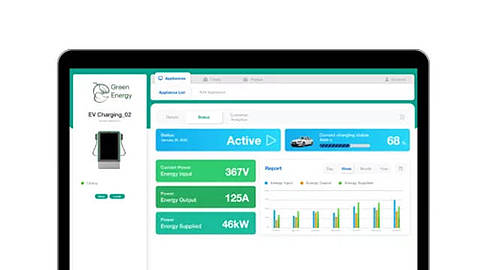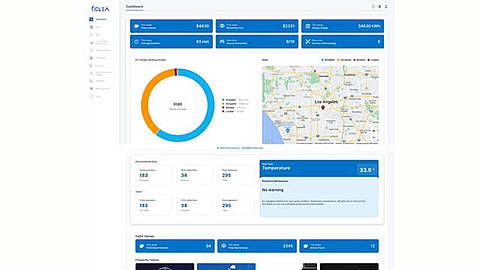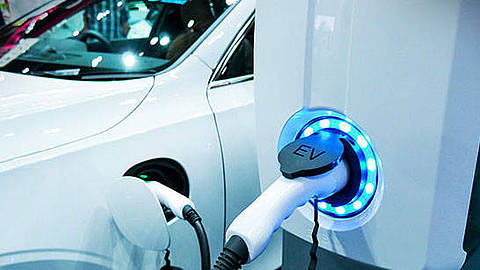An Edge AI platform for the optimized management of charging stations
A study conducted by the charging provider organisation ChargeUp and the consultancy P3 Automotive illustrates how quickly the sustainable mobility ecosystem is also growing in Europe: the total number of publicly accessible standard current charging points in Europe [1] has increased by 580% since 2015. Currently, the European charging infrastructure network has more than 330,000 charging points, primarily concentrated in the Netherlands (122,000) and Germany (65,000). (Source: State of the Industry Insights into the Electric Vehicle Charging Infrastructure Ecosystem, ChargeUp & P3 Automotive, 2021).
Until recently, the geolocalization of charging stations was considered sufficient to facilitate their use. Today, however, it is becoming increasingly important to provide additional services including the real-time detection of service status, occupation by vehicles, availability within a certain mileage or travel time, and available payment options. Introducing additional servitization functions makes it possible not only to build customer loyalty but even expand the basin of users to the local community, allowing the manager to integrate their core business with new revenue.
Clea is the Edge and Cloud AI modular platform by SECO, which thanks to its extremely flexible configuration and the possibility to run vertical applications both on Edge and in the Cloud, allows public and private network managers to transform electric vehicle charging stations into smart devices ready for data analysis. Thanks to a set of specific Apps for the EV charging market, Artificial Intelligence models process the data collected from charging stations, returning it in the form of helpful insights to better manage and optimize the network, in addition to enabling offers for additional services allowing increased revenue. The benefits of transforming a charging network into a network of Edge AI devices are manifold. Let’s take a more detailed look.
- Data processing at the source: less latency and greater security. Implementing an Edge AI solution such as Clea means most processing can occur at the charging station itself, transferring a minimal percentage of data to the cloud, thus significantly speeding up data collection times. Moreover, reducing the “dimensions” of the data before sending it to the cloud platform not only reduces power consumption and transfer and redistribution costs but also increases the overall security of the entire procedure.
- Artificial Intelligence aids in predictive maintenance policies and remote assistance. One of the deciding factors in ensuring a positive user experience is the efficiency of the stations. The Clea AI models constantly monitor the operating status of the charging stations and intervenes before the failure occurs and the service is interrupted, thus avoiding machine downtime and all the resulting consequences. Variations in the measured values concerning the normal operating status make it possible to predict where and when the failure will occur and thus take early action to resolve the malfunction, reducing downtime and avoiding a chain reaction that may otherwise lead to the breakage of other components in the same machine. Predictive maintenance therefore not only optimizes performance by approximately 22 % but above all, reduces assistance costs by 37%. The continuous monitoring of every single component of the EV Charging Station allows operators to remotely examine its condition, viewing the temperature of the modules, cables and battery, and in case of alarms, reducing the delivered kWh to bring the value below the recommended limit, and also monitor the energy management and cooling systems status. And since even the applications and operating system can be updated remote, using the Clea web control panel, setup call-outs are reduced by up to 58%.
- Edge AI reduces ordinary assistance costs. The real-time activation of alerts allowing “prompt intervention” improves the efficiency of the entire network in charge of routine maintenance and on-site assistance. Also, in this case, the response time between the occurrence of the failure and its resolution is critical in providing the best possible service. The low latency on the collected data and activation of the closest help centre can reduce call-out costs by 47 % and in general by up to 37 %.
- Plate and Car Detection. Clea integrates specific AI models allowing the real-time viewing of the characteristics and number plates of the vehicles occupying the charging stations, with subsequent monitoring of their dwell time. This allows more efficient management of the space reserved for charging, intervening in cases of improper occupation or the event of problems making payment. The data log then provides valuable information regarding the number and type of vehicles, dwell time and any queues that may have formed.
- Pricing & Revenue Manager and contactless payment with KarL4. To optimize pricing management, Clea offers the Revenue and Price Manager service which provides an overview of revenue and profits, advanced charging session analytics, and much more still. Clea AI can also suggest the best price, which can easily be set through the app. Ad hoc promotional campaigns can be simultaneously launched, with offers and discounts entirely overseen by the manager. Clea is natively compatible with the SECO KarL4 contactless payment terminal, which, once installed on the charging station, allows clients to make cashless payments for amounts up to 50 euros by simply waving their card, without needing to key in a PIN. With the possibility for personalization to suit the manager’s needs, KarL4 is compatible with Google Pay and Apple Pay, to make transactions by simply waving an enabled smartphone or smartwatch over the reader.
Flexibility and servitization: the benefits for managers and clients
Increasing revenue by introducing new servitization functions is one of the policies commonly practised by advanced technologies such as Edge AI. The possibility to equip charging stations with displays on which to project not only information about the station itself but above all smart signage and targeted ads allows network managers to significantly expand their business scenarios. The stations are transformed into tools through which to generate new revenue, selling advertising spaces or offering additional services concerning vehicle charging alone.
Clea allows the integration of Digital Signage functions by simply fitting the network charging stations with a monitor and camera: dedicated AI models which are run “on the edge” (Age and Mood Recognition) detect the age and mood of the user, allowing personalized promotions and the transmission of targeted ads during and after recharging. Integrating the telemetry data thus collected makes it possible to:
- analyze the audience and number of ADVs conveyed, sorted into specific age groups or moods;
- manage the various ads and create specific campaigns for certain client age groups and attitudes;
- monitor the data relating to each ad with filters on the audience and viewing time.
The flexibility of Clea AI for electric charging stations allows increased revenue, reduced maintenance costs, and an improved customer experience thanks to the greater involvement of clients. Results that testify to the full potential of this artificial intelligence platform can improve not only the company’s business but also mobility within the community where it is used.
Contact us and know more about Clea for EV Charging Stations.
[1]Normal charging points supply up to 22 kW of power, while rapid charging points supply over 22 kW of power.


